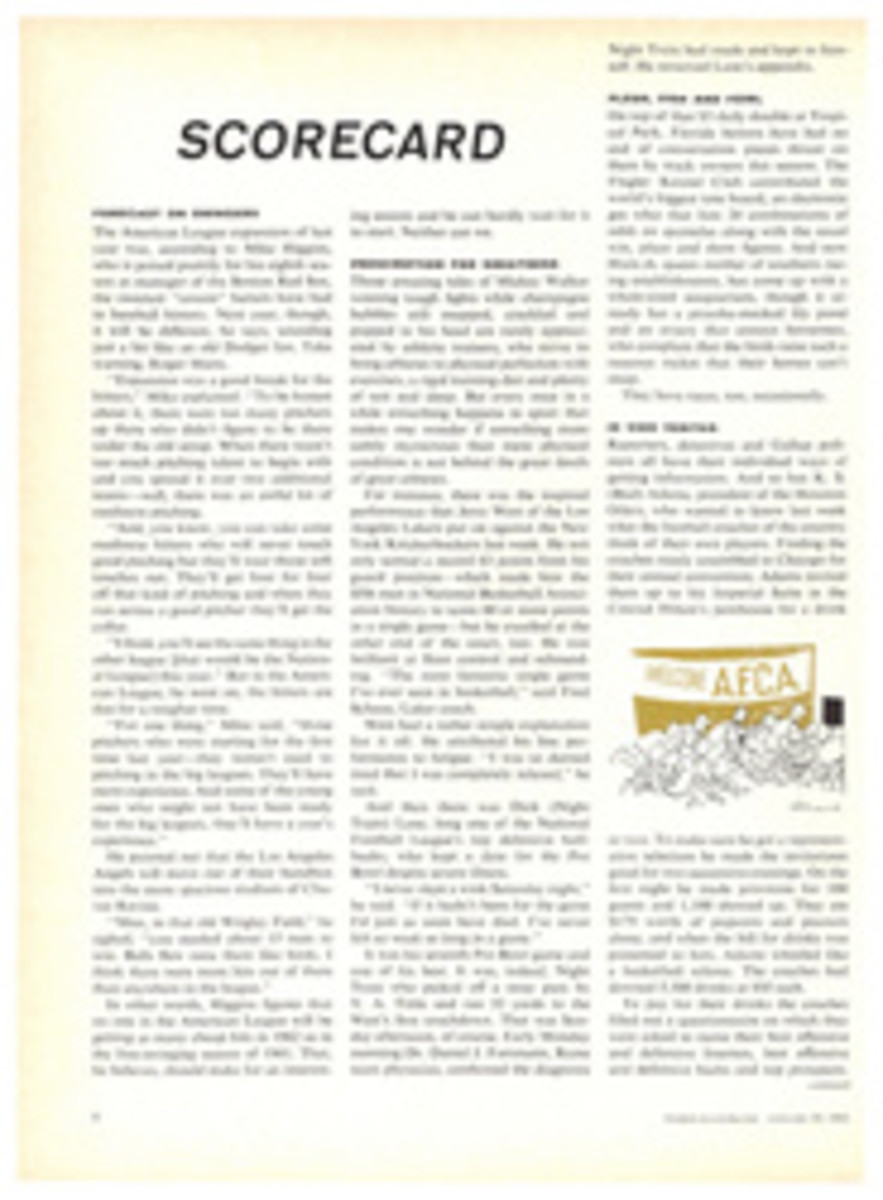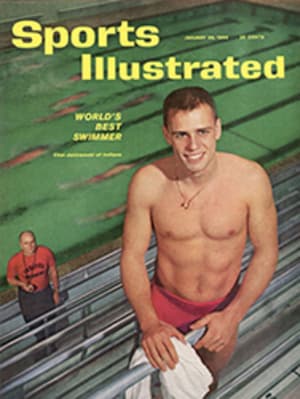
OVERCOME BY BEAUTY AND BEATTY
Indoor track, that steadily growing spectator sport, brilliantly opened its western season in the Los Angeles Memorial Sports Arena last week before a full house of 13,622 people. The meet was a fine one, much better—from the standpoint of the competition entered—than the indoor meet in Boston which preceded it by a week. This was a source of satisfaction to the backers of the Los Angeles meet and, perhaps, a source of some dismay to the promoters of eastern indoor track. Until the last few years they have had things pretty much their own way in the procurement of track and field talent.
There was an indication of great things to come in the final race of the evening in Los Angeles. It was a beautifully run mile between the best indoor miler in the U.S., Jim Beatty, and a young Frenchman named Michel Jazy (pronounced like the Zsa of Zsa Zsa Gabor, plus "zee"), who may well be the best miler—indoors or out—in the rest of the world. Beatty won the race in the painfully short stretch from the corner to the tape, edging Jazy by a foot. Both runners were timed in 4:04.8, a remarkable performance for so early in the indoor season.
This was the only race Jazy had ever run on boards and the only one he will run in the U.S. on the indoor circuit. A linotype operator for L'Equipe, the French sports paper, he was able to leave his job only long enough for the one appearance. Significantly, he chose to run in California rather than in the East.
The Los Angeles meet is one of three scheduled for the West Coast this season. There will be another in Los Angeles and one in Portland. Add to these five indoor meets in Texas (where there were none two years ago), a very good meet in Louisville (in its second year), and another proposed for, of all places, Las Vegas, and it is evident that the old eastern monopoly of indoor track stars is in imminent danger of being broken.
Before the Los Angeles meet there was considerable speculation about the mile. Beatty, of course, is well known to track followers. He came to the race in the best early condition of his career. Both Beatty and his coach, Mihaly Igloi, felt that, given a reasonably fast first half, he could break Ron Delany's indoor record.
Jazy, a slight, blond and handsome 25-year-old who looks like a rock-and-roll singer, had run no miles this season and, despite his second-place finish to Herb Elliott in the Olympic 1,500 meters in Rome, was considered something of an unknown quantity. He had won three races this winter in France, but they were all in cross-country.
Jazy trains in Marly Forest, on the outskirts of Paris. When he reached Los Angeles early in the week and went to the track at the University of Southern California to work out, he watched in amazement as the USC team tooled steadily around and around. "How can they do this?" he asked. "It would kill me with boredom. It does not seem to give you firm enough training. It is very firm in the Marly Forest, where you run up and down hills."
He managed to overcome his aversion to the monotony of training on a track, however. Once he worked out at the same time as Beatty at the Los Angeles Track Club. He had intended to run a three-quarter mile against time but, when Beatty arrived, he changed his regimen. Instead, he watched his future opponent work under the instructions of Igloi and decided to train in the same way that Beatty had.
Off the track, Jazy spent much of the week wandering around Los Angeles with a French television crew, acting in what is to be an hour-long French TV show, which might be entitled, The Adventures of Michel Jazy in Hollywood. When he gives up running, he may qualify as an actor. He played his role in the television show easily.
He was vastly interested in the natural wonders of Los Angeles. Once, standing in the lobby of the Sheraton-West Hotel, where he was staying, he stared thoughtfully at one of the young, pretty and bosomy girls who decorate this area almost as thickly as the palm trees. "Ssst!" Jazy whistled appreciatively. "She does not mind how much of her lungs are showing, does she?" He said this in French, fortunately. He speaks only a few words of English.
The morning of the meet, he repaired to the sports arena with the television crew to take his first look at boards. He trotted gingerly around the 11-laps-to-the-mile oval, went through his paces for the camera with assurance, then, through an interpreter, questioned an American track coach on the strategy and tactics of the indoor mile.
"Where," said he, "does one normally launch the attack?"
"Coming off the turn," he was told. "You must be very careful coming off the turn. Accelerate. Most indoor milers sprint out of the turn if they want to take the lead."
"Where does one run?" he asked next.
"On the rail."
"And on the turns? Does one run differently?"
"Relax and lean into it," the coach said. "Move your arm across your body like this." He demonstrated, and Jazy trotted around a turn, moving his arm properly. He stopped and nodded.
"And the tactics," he said through his interpreter. "What should they be?"
"That's the easiest," the coach told him. "You stay one step behind Beatty until you're ready to attack. Then you get up and go."
Both Beatty and Jazy are very strong finishers. Neither likes very much to set a strong pace. They might have run a faster mile Saturday, but the pacer—Leroy Neal of Occidental College—failed to run the first quarter in 59 seconds as planned. Instead, his time was a rather pedestrian 61.5, with Beatty a step behind him, and Jazy, as planned, a pace farther back.
In a move unusual for him, Beatty took the lead at the beginning of the second quarter, trying to quicken the tempo to place him within reach of the indoor-mile record. Jazy, running with a looser-jointed stride than the neat, economical one Beatty uses, moved with him. From there on, he followed the script he had been given in the morning almost as well as he had followed the TV script all week. With a lap and a half to go, he kicked very strongly, passing Beatty and, briefly, opening daylight between them.
Beatty came on again in the back-stretch but Jazy held him off as they went into the last turn, stride for stride. Coming off the turn, Jazy was some two feet in front. But Beatty, who must have the strongest 30-yard kick of any miler in the world today, turned on that extra speed and won at the tape. It made an exciting, if sad, ending for the Jazy television extravaganza.
The next indoor meet in Los Angeles is February 10, when the Los Angeles Times has its third annual competition. Glenn Davis, the old Army All-America halfback, is the assistant promoter for the Times. He would not say who he has lined up but it is very likely that two of the top foreign stars in the 1960 Olympics will be on hand. It is not at all likely that they will run in the East after the Times races.
The entry list for last Saturday's competition included Ralph Boston (who broad-jumped 24 feet 11 inches); Wilma Rudolph Ward (who looks 15 pounds heavier than she did in the Olympics and who was upset in the 60-yard dash); Frank Budd (who won his 60-yard dash easily and looks to be even faster than he was last year when he broke the world 100-yard-dash record); Hayes Jones, the nation's best high hurdler, and a large assortment of the rest of the best trackmen in the U.S. Much of that talent lives in southern California or elsewhere on the West Coast. Last week Jumbo Jim Elliott brought his superb Villanova track team West and won most of the events he entered. Indeed, two real track powers emerged at the meet—Villanova and the new Los Angeles Track Club, coached by Mihaly Igloi. The latter is made up of distance runners. One of them, Laszlo Tabori, won the two-mile. Another, Jim Grelle, won the 1,000 by a foot over Villanova's impressive freshman, Tom Sullivan. The third was the villain in the French TV show—Jim Beatty.
PHOTO
BEFORE RACE WITH BEATTY, RELAXED JAZY GAZES WITH WIDE-EYED INTEREST AT SPIKE-HEELED TRACK FOLLOWERS IN L. A. ARENA

